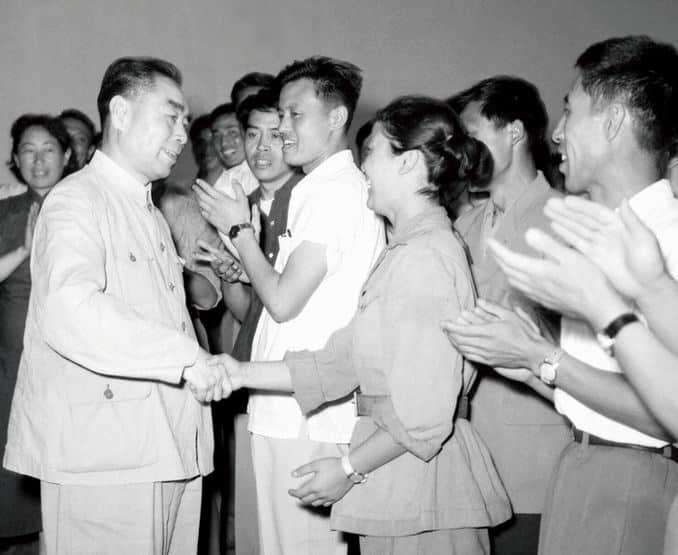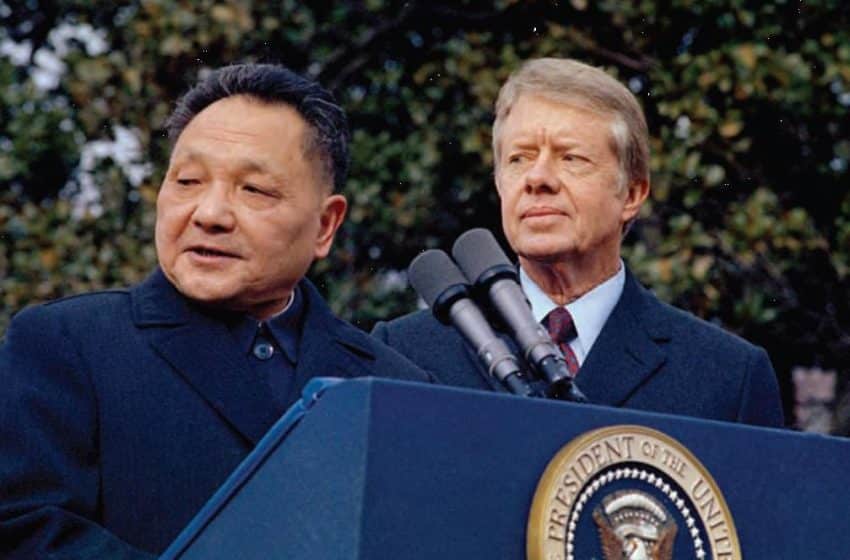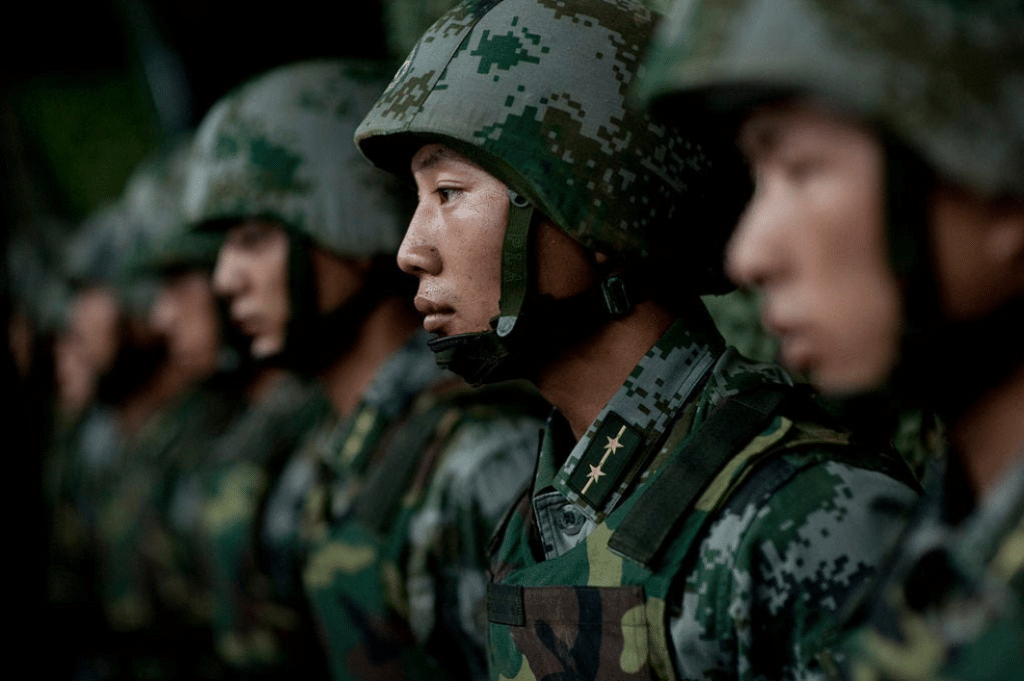China Vérité: Ying Qian on Documentary Cinema, Part 1
- Interviews
 Kay Zou
Kay Zou- 08/29/2024
- 0

Ying Qian is an associate professor in Columbia University’s Department of East Asian Languages & Cultures. She is interested in how media shapes politics, forms knowledge, and connects realms of experience. She is the author of Revolutionary Becomings: Documentary Media in Twentieth-Century China, a history of documentary filmmaking from the end of the Qing Empire in 1911 to Reform and Opening Up in the 1980s.
Kay Zou: What is a documentary?
Ying Qian: When I teach documentary in classes at Columbia, students come already with a lot of exposure to the medium. PBS documentaries have been a cultural staple in American cultural life. Viewers today also see many documentaries on streaming platforms where it’s an important category. Historically, documentary has long been associated with political and social movements.
It was the preferred form of filmmaking for radical film groups in the 1920s and 1930s, including the Workers Film and Photo League in the United States and Prokino in Japan. It also figured importantly in the activist film cultures of the 1960s and 1970s, as in works by the Dziga-Vertov Group in France, the Newsreel groups in the United States, and the Third Cinema of Latin America.
Now as our digital culture has made it easier to share videos, we instinctively pull out our phone when we see something worth documenting and sharing, and short digital videos in the documentary mode have become omnipresent and are where we learn about what’s happening in the world.
“Documentary,” derived from the word document, was first coined in English by the British filmmaker and critic John Grierson in the 1920s. The film historian Philip Rosen has shown that “document” in the 19th century commanded a great deal of respect with the development of modern empirical sciences, and evidence-based historiography and the legal professions. Grierson’s naming of “documentary” tapped into this reverence for the “document,” positioning documentary as a mode of cinema closely related to scientific investigations, evidence-based argumentation, and public education.
Of course, we know that, even in empirical science, the investigator has a lot of discretion. Anthropologists who study the culture in science labs, and historians of science who study how scientific discoveries come about, have shown that the paradigms we use to assess the physical reality around us, and the data we collect based on these paradigms, come from preconceived ideas about how the world works. This is why peer reviews are so important in scientific research, as each individual process of generating evidence and arguments must be interrogated and put into conversation with those done by other researchers. It’s the same when we consider other forms of knowledge, such as social knowledge.
KZ: How so?
YQ: If the society is a huge totality of complex phenomena, whatever representation we have of it or whatever inquiry we make is by nature partial. And the specific partiality with which we present the reality we experience depends on our positionality and our situatedness – and our intention, what kind of story we want to tell. It also depends on how we interact with the prevailing norms of storytelling and knowledge formation – are we aware of these norms? Can these norms help us tell our stories and describe the world as we know it? Do we have the means to go beyond these norms, that is, to innovate on how to tell stories and form social knowledge?
Now coming back to documentary. To think about documentary as a document, we should look at it with the same level of sophistication, as we would look at a historical document. How does this historical document come about? Who wrote it, under what circumstances, within what power structures? Documentaries tell stories about the physical and historical worlds we live in, and what kindn of stories they tell depends on the positionality of the filmmaker, the power dynamics between the filmmaker and what’s in front and around the camera, and the broader political and social situations in which the filmmaking takes place.
KZ: How has the practice of documentary filmmaking changed over time in China?
YQ: I hope your readers are interested in history, because as a film historian, my impulse is to offer a narrative of documentary’s development over a longer period. I am very involved in Chinese contemporary documentary, especially independent documentary. But I think a historical perspective will give depth to our understanding of documentary’s long engagement in mass politics, which explains why it’s so contested in today’s China and beyond it too.
China had been a location for documentary filmmaking since cinema’s earliest years. Starting from the end of the 19th century, filmmakers from Britain, France, Germany, Japan, and the United States all traveled through China to take moving images. These were then marketed globally either as one-off “travel actualities,” or starting from around 1910, as regularly released newsreels, entertaining filmgoers with exotic vistas and news events from around the world.
It’s worth noting that this sensorial reach into the world enabled by cinema was part of a broader culture of imperial expansion and colonization, when the world was seen to be within reach, as markets, resources and territories for settlement.
Chinese documentary filmmaking began in the early 20th century. Unlike the itinerant cinematographers dispatched by major western film studios who were supported with good filming technology and a global infrastructure of rapid processing and distribution for international markets, early Chinese filmmakers had very limited technology, access to location, and infrastructure, and they made films not for an international audience, but for filmgoers in China’s urban centers. Therefore, documentary filmmaking was closely connected to China’s politics from the beginning.
KZ: What were their films about?
YQ: The late 19th and early 20th centuries saw Chinese society going through reform and revolution. The earliest documentaries I wrote about in my book were a 1906 film made by Chinese students in Japan on building the Qing Dynasty Navy, and a series of documentaries on the 1911 revolution led by Sun Yat-Sen and his Revolutionary Alliance that in the end toppled the Qing Dynasty. Both were part of political movements.
After 1911, many political forces, including political parties, warlords, and the new political force of the working class, competed for power, and they all resorted to filmmaking – the new media at the time – for member recruitment, fund-raising, and publicity. Commercial publishers such as the Commercial Press and civic organizations also made films for educational purposes and for organizational fundraising purposes.
Chinese filmmakers in the early 20th century moved fluidly between documentary and fiction film production. Lai Man-Wai, a filmmaker who hailed from Hong Kong and a long-time member of Sun Yat-Sen’s Revolutionary Alliance, made documentaries for Sun’s Nationalist Party and filmed the Nationalist troops in a successful Northern Expedition (1924-1927) to regain political control of much of the country. Lai was also a major producer for feature films and used documentary footage as backdrops for his feature film – a romance – set during the Northern Expedition.
The 1920s and 1930s was the golden age of Shanghai feature filmmaking, though Chinese filmmakers also responded actively to important political events in the documentary mode. Filmmakers took risks to document the workers’ uprising in 1925, and the Japanese air-raid of Shanghai in January 1932.
The latter turned out to be very challenging undertakings for Chinese filmmakers, because their film studios were heavily damaged during the bombing, and as Chinese they had more limited access to the city compared to western filmmakers who had the protection of neutrality and could move in and out of foreign settlements more easily.
It’s fair to say that Chinese documentary from the beginning had been embedded in political and civic lives; they were often partisan and proudly so. And by 1920s and 1930s, Chinese filmmakers had thought very consciously about positionality. They didn’t treat documentary as a “neutral” or “objective” medium. but understood it as a means of political intervention, to tell “their side of the story.”
During the Second Sino-Japanese War (1937-1945), documentary film production went through rapid development. Prior to the war, the center of filmmaking was in Shanghai. When Shanghai was captured and occupied by the Japanese army, some filmmakers stayed on, but most joined resistance – a large number went inland to Chongqing, the wartime capital of the Nationalist Chinese government, a small number went to Yan’an, the Chinese Communist Party’s stronghold in rural Shaanxi, and some went to Hong Kong.
In Chongqing, documentary production centered at two state studios under the Nationalist Party. A large number of filmmakers – including leftist filmmakers – worked at these studios. Documentary was the most important mode of Chongqing cinema. Documentaries were expected not to show reality as it is, but to capture “winning realities.”
Filmmakers hoped their films could usher in victories, by encouraging Chinese troops, demoralizing the enemy, and rallying for resistance. There was a lot of discussion on how to mobilize effectively with documentary, and how China must do it better than the Japanese and the German armies, who had been making rousing propaganda documentaries.
During the war, as part of the allied forces, China joined the circulation of images across the allied countries and was a filming destination for international filmmakers. Joris Ivens, a leftist Dutch filmmaker who had made films in the Soviet Union and worked with the workers’ film and photo league in New York, came to Chongqing in 1938 to make The 400 Million (1939). Chongqing filmmakers also contributed footage to Frank Capra’ s The Battle of China (1944), made for the American military to train American soldiers who now must fight in unfamiliar places far from home, when the U.S. entered the war after Pearl Harbor.
KZ: You mentioned Yan’an. What about filmmakers working with the Chinese Communist Party?
YQ: In Yan’an, the first film unit directly under the supervision of the Communist Party was founded in 1938. The filmmaker responsible for the founding of the Yan’an film troupe was the talented Yuan Muzhi, a leading actor and film director in Shanghai prior to the war. He wanted to build a new Communist cinema in Yan’an, and believed such a new cinema must be based on documentary, a medium closest to the struggles on the ground.
Yan’an was under frequent Japanese raids and Nationalist attacks and blockade, had little film stock and processing capacity, and only two cameras – one of which was donated by Joris Ivens – so it had only a small output. It was only at the end of the war, when with the help of the Soviet Army, Yan’an took over Japan’s colonial film establishment in Manchuria (the Man-ei in short) that Communist filmmaking began to flourish. A large number of filmmakers were trained by Yan’an filmmakers with the support of Man-ei staff and technology and were dispatched to the war front to document the Civil War (1946-1950) in which the Communist troops emerged as the winner to take state power.
After the People’s Republic of China was founded in 1949, documentary was considered the “vanguard of cinema.” It was closely supervised by the Party, with centralized post-production at its headquarters in Beijing (the Central Newsreel and Documentary Film Studio) and cinematographers stationed at regional offices around the country. This meant that cinematographers could quickly respond to all the events on the ground, while the center retained control for editing, compilation, and interpretation.
The 1950s was a period of radical social transformation. With the expansion of film exhibition across the country, largely through expanding mobile film units that took films on arduous journeys across difficult terrain to China’s vast countryside for mass screenings in open air, cinema joined propaganda posters and pamphlets, and the expanding radio network, to play an important role in political communication.
Documentary depicted domestic campaigns such as the land reform and the nationalization of private enterprises, and international events from the Korean War to the Bandung conference. During the Great Leap Forward production campaign (1957-1960), documentary was the fastest growing mode of cinema. Filmmakers felt safer making documentaries, as changing politics around the Anti-Rightist campaign (1957) had made it unclear what a politically correct feature film would look like. But more importantly, documentary could be speedily and easily made, and therefore suited the fast speed of the Great Leap.

KZ: Was documentary used just to celebrate the supposed industrial victories of the Great Leap of was there a broader significance?
YQ: It’s very interesting to think about how documentary contributed to a larger productivist environment that propelled the backbreaking work of the Great Leap Forward. For example, documentaries were used to train millions of new workers who came to the cities from the countryside and must learn to adapt to a completely different mode of work in industry.
As even larger numbers of people in the countryside were mobilized to build reservoirs, and there was also a drive to boost iron and steel production by mobilizing people to build “backyard furnaces” for metal work, documentary films, along with lantern slides and other visual aids, served to propagate these technologies, similar to how DIY videos are used today.
The Great Leap Forward also saw the new practice of “artistic documentary” which combined documentary with fiction, even science fiction. Commentators and cultural bureaucrats agreed that documentaries could “document tomorrow.”
This may sound strange, as the future, by nature, is not readily available to the documentary lens of the here and now. But if we think back to the history of Chinese documentary that I had outlined, it is not strange – Chinese documentary had always had a prospective dimension: it intervenes into a dynamically changing world and tries to move it to favorable directions.
Documentary contributed to a culture of ungrounded optimism. It helped the state mobilize people to work 24/7 and hasten the utilization of untested technologies. The consequence was devastating: the Great Leap ended with massive famine.
KZ: The years after the Great Leap are a period of major course correction. Was this reflected in Chinese documentary filmmaking?
YQ: If Great Leap documentaries were confidently imaginative, engaging in formal innovations such as docu-fiction to propel a leap into a better tomorrow, documentaries in the years leading to and during the Cultural Revolution became more and more formalized and conservative.
These years were characterized by a militant vigilance against Soviet revisionism and an intensification of political struggles. As “class struggle” must continue (in contrast to the revisionist Soviet Union, who allowed class struggles to lapse), and as behavior and thought were now the only criteria to tell a “capitalist-roader” apart from the “revolutionary masses,” documentary registered increasingly stereotypical performances of “revolutionary” thinking and behavior that would unmistakably place the performer in the ranks of the people, rather than the capitalists.
The striving for documentary’s full epistemological potential – let it both map and wander, both analyze and observe – was what characterized documentary practice in the 1980s, the decade after the Cultural Revolution ended in 1976.

KZ: How So? What Changes in filmmaking after the Mao-era?
YQ: The 1980s was an extremely complex period when the country had to reckon with its recent history, particularly the Cultural Revolution, while undergoing economic reform. Documentary in this period was absolutely fascinating: it was observational, poetic, reflexive, and it attempted to reclaim its vanguard position – to truly mediate the relationship between the Party and the people, and create the pertinent social knowledge needed to move the society to a better place. As documentary production shifted to television, the new media of the day, documentary entered homes and became topics of daily conversation.
Today, when we speak about Chinese documentary in an international setting, the films that come to mind tend to be works by independent documentary filmmakers who began to make films in the decades between the 1990s and the present (such as Wu Wenguang, Feng Yan, Li Hong, Wang Bing and Zhao Liang, just to name a few). Independent documentaries are close to my heart, as I began my research in documentary by joining communities of indie filmmakers. And we can talk more about independent documentary in our next questions.
What I try to sketch out in this brief history of Chinese documentary is the following. First, documentary has been political since its earliest years in China. It’s deeply embedded in political movements, party politics, and reform and revolutionary projects, and their reckonings. Its production relies on the power relationships around the camera, yet also changes such a relationship in the production process.
Documentary’s work with politics and with power is a shared legacy for documentary around the world. In the U.S., documentary had been important for political activism from unionization and anti-war movements to civil rights movements and movements for LGBTQ+ rights. Documentary is at its strongest when embedded in political and social movements.
Second, documentary is epistemologically important for the formation of various kinds of knowledge, particularly social knowledge. This has to do with documentary’s collaborative nature – it gathers many different points of views. It also has to do with documentary’s capacities in both analysis and observation.
Third, while there was a tradition of personal documentary filmmaking in the U.S., and other places such as France, Germany, the U.K., and Japan, in China, documentary had for a long time been associated with institutional filmmaking, particularly with the state. Only in recent decades, personal filmmaking became possible with DV technology.
In film studies, we are moving beyond an auteurist approach to cinema. While personal filmmaking is fascinating and I am deeply in admiration for many filmmakers’ works, we now see cinema’s omnipresence in many places beyond the theater and the festival circuits. Great Leap documentaries, for example, offer an example of cinema’s use in industry. Understanding documentary history is to broaden our understanding of what cinema is, where it’s located in the society.
Kay Zou is a student at Columbia University studying History and Political Science. Her research focuses on the global Cold War and Chinese elite politics.
The views expressed in this article represent those of the author(s) and not those of The Carter Center.
Author
-

Kay Zou is a student at Columbia University studying History and Political Science. Her research focuses on the global Cold War and Chinese elite politics.
China Focus Intern







